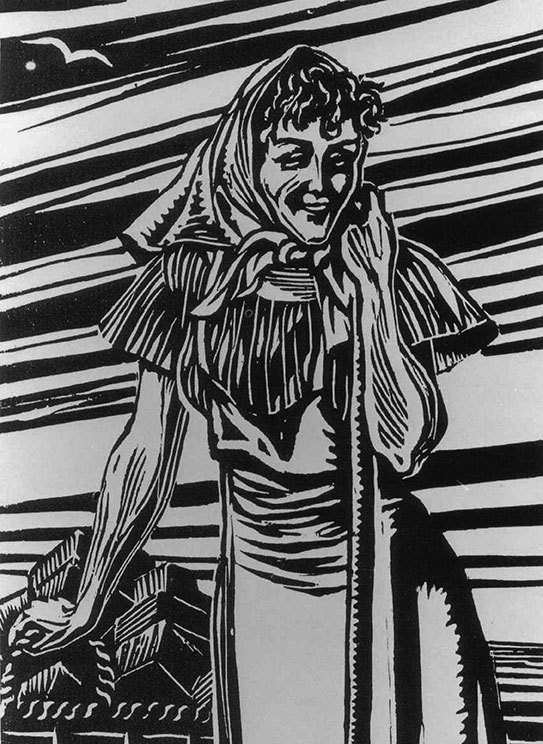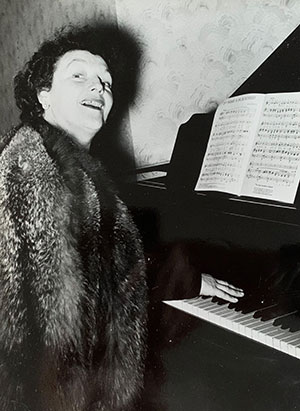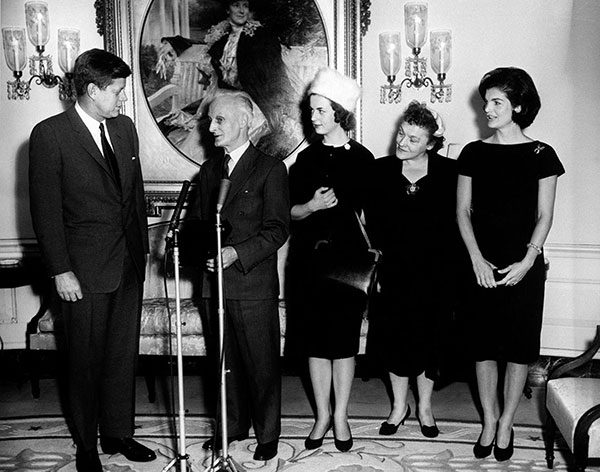By Aidan O’Hara
Delia Murphy was the best-known Irish woman of her day, and the most popular female vocalist in Ireland from the late 1930s to the early ’50s. She was also the country’s top recording artist, of traditional songs like The Spinning Wheel, Three Lovely Lassies from Bannion, The Shores of Lough Bran, The Croppy Boy, and two of her own songs, The Moonshiner (I’m a rambler, I’m a gambler) and Dan O’Hara.
Background

She was the daughter of Mayo man John ‘Klondike Jack’ Murphy, who returned from America in 1902 after amassing sufficient funds from mining to buy Mount Jenings House and the surrounding farmland, near Claremorris. Delia was born in the same year. As a child she picked up ‘come-all-ye’s’ from her father, from other singers who attended sessions in the basement of the Murphy house and from the family’s housekeeper, Mary Cassidy, who recalled:
‘She got a few from a local man called Jamesy Mellett, a postman. And I gave her a few. She got the words of the song Combing her hair by candlelight from Jamesy. We all helped her out as best we could. I gave her a song called The Sailor Boy.’
Delia, however, attributed much of her repertoire of songs to Travellers who camped in Featherbed Lane, which ran along the edge of the Murphy farm.
At boarding-school, first with the Presentation Sisters in Tuam, Co. Galway, and later at the Dominican Sisters’ school in Eccles Street, Dublin, Delia was singing in choirs and performed Stephen Foster songs at school concerts. When she was studying at UCG in the early 1920s she was popular at college functions and parties. Bríd Ní Bhroin, a fellow Commerce student, remembers being impressed with Delia’s appearance and manner right from the start:
‘She was very attractive and great fun at hoolies and sing-songs. She was a very fine singer even then. I remember she sang all sorts of ballads and mostly light songs. She was great company and very generous, very open.’
One of those who heard Delia sing at a party was Thomas Kiernan, tax inspector for Galway at the time. They fell in love and were married in 1924; soon afterwards, he was appointed secretary to the Irish high commissioner in London. There Delia met many of the famous names of the day—W.B. Yeats, James Joyce, Fritz Kreisler and the Prince of Wales. Son Colm Kiernan later observed that the London years were important for his mother because at those occasions, where there were a lot of Irish present, she did what she liked doing most—singing songs at impromptu sessions around the piano: ‘She was finding an audience, learning what kinds of things they wanted to hear. They were chiefly exiles’ songs.’

Best-selling records
In 1935 the career of her diplomat husband took a very different direction when the government appointed him Director of Programmes at Radio Éireann in Dublin, where Delia continued to give impromptu performances at functions. One of those who was impressed with what he heard was Leslie Thorn, manager of the record company HMV (His Master’s Voice) in Ireland. He recorded her and in no time at all she was making an impact on the Irish entertainment scene. Before Leslie Thorn established HMV’s office in Ireland, there was a dearth of Irish traditional material available to record-buyers. Thorn felt that Delia’s singing would go a long way towards rectifying the situation.
And what was the reaction to her recordings when they first came out? According to Thorn:
‘She got along well with “society types” in Dublin, but most of them did not care all that much for her songs. They were inclined to look down on the sort of songs Delia sang, but then they began to be less snooty about it all after Delia came on the scene.’
Colm Kiernan concurs:
‘It would be fair to say that in “polite” circles in Dublin she was scathingly referred to as either a tinker or as someone who sang their music; as a mother who was neglecting her home duties in favour of trailing her coat, or in some such disparaging terms.’
Delia’s songs, however, were much in demand by listeners to music programmes on Radio Éireann and her record sales were far ahead of her nearest rival. HMV’s Leslie Thorn ‘hoped that because of Delia’s husband’s position in Radio Éireann her recordings would get plenty of air-time’. According to Colm Kiernan:
‘The fact that my father was Director of Programmes had a bearing on the outcome. While he never influenced anyone to play her music, and while there were thousands of letters that requested her music, the fact that he was Director doubtless influenced programme selection in Henry Street [Radio Éireann’s top-floor location at the time in the GPO].’
Start of a trend in folk music

The up-and-coming young Dublin tenor Hubert Valentine met Delia in the offices of HMV in Eustace Street when they were making arrangements to record her:
‘The come-all-ye’s were not popular. As far as I was concerned, to me that sort of singing was what you’d hear from a fella who was half-drunk. I had never heard them. I liked and didn’t like the quality of her style of singing. I was “legit” classical, you see. But she grew on you, and she could do the folky song. She wasn’t considered by most of the singers in those days as a singer, let’s face it. She started the trend in folk music that came on in later years. At first people said, “Isn’t she awful?”, but as she became popular, she was wonderful.’
Delia had an unerring knack of coming up with songs that were catchy in word and melody. ‘She was one of our own who wasn’t cramped by convention,’ said Seán Ó Síocháin, former president of the GAA, who sang on stage with Delia many times. ‘The themes of her songs struck a chord with the people. She had enormous appeal.’
From 1938 to 1941, concerts and recordings were to be Delia’s main interest outside of family concerns, and her engagements took her all over the country. Seán Ó Síocháin recalls the typical concerts in which he and Delia appeared in the early 1940s:
‘Those performing were a mix of visiting and local artistes, and the purpose was most often for some local charity or fund-raising venture—the GAA, the parish, the Gaelic League, that sort of thing. There’d be a comedian, singers, dancers—these were usually locals—and instrumentalists. Delia, of course, would be the “star” attraction. Albert Healy was one we regularly performed with, and Pascal Spelman, the Limerick comedian, and the harpist Máirín Ní Hea, and the singer Máirín Fenning.’
Ó Síocháin said that Delia’s style of singing was close to what he had grown up with in County Cork:
‘Very few others had that way with the ballads, especially the ladies. If there was anything conscious in her presentation of herself and her songs, it was that she wanted to recreate on stage the background from which she came—the style of singing that nothing was going to curtail and nothing would in any way cut down on her way of expressing a ballad.’
Novelist Leo Cullen, Delia’s nephew, said that she encouraged a hard-drinking image of herself at times: ‘It was her way of thumbing her nose at convention, and that comes through in one of her most popular compositions, The Moonshiner, also known as I’m a rambler, I’m a gambler’.
One day in 1938, quite out of the blue, Delia was offered a part in the film Islandman, which was being made on the Great Blasket Island off the coast of Kerry. The script for the hour-long movie was written by Kerryman Donal O’Cahill, who had also been involved in the 1934 film The Dawn, which was produced by T.G. Cooper of Killarney. The original plan was that Delia would help out Butcher Films of London by bringing her children to Kerry to take part in some of the crowd scenes. The producers needed someone to play the part of the mother in the film, however, and they asked Delia whether she would do it. She agreed but was not at all impressed when she saw herself on screen wearing a shawl, playing the part of an older woman. She frankly admitted that it was a blow to her ego: ‘I was disillusioned almost to the verge of tears’.

Posted overseas
In October 1941 Thomas Kiernan was appointed Ireland’s minister plenipotentiary to the Vatican. Delia had to abandon her singing career just as it was taking off. In Rome she met up with the famous Monsignor Hugh O’Flaherty, who was engaged in secret work helping escaped Allied prisoners of war. Delia ‘lent a hand’ in the work with the Kerry priest, who became known as the ‘Scarlet Pimpernel of the Vatican’, and to hear her later reminiscences one would think that between the two of them they had won the war against Hitler!
After their time in Rome the Kiernans were posted to Australia, where Thomas Kiernan was appointed Ireland’s first representative to that country. Delia sang occasionally at functions but was not all that happy with life in Canberra. On their return to Ireland in the early 1950s she was determined to resume her career as a singer; when her husband, much to his surprise, was posted back to Canberra, she continued touring Ireland and Britain. On BBC radio programmes she was hailed as ‘our Delia’. In the May 1953 edition of Hibernia Magazine, R.M. Fox, in his regular ‘Portrait of an Artiste’ column, entitled ‘Delia Murphy: Ballad Singer of Ireland’, wrote:
‘One of my most vivid memories is of Delia Murphy standing on the stage of a Dublin theatre while the audience, ranged in tiers from pit to gallery, roared its appreciation of her songs and demanded more. Dark-eyed and dark-haired, with strong expressive western features, Delia is an artist of temperament. When she sings Irish ballads she puts the passion of this folk music into her eyes, voice and manner. Thousands have heard her singing over the radio, many have listened to her gramophone recordings, but luckiest of all are those who have seen and heard her in person, giving full expression to the mood of the song—plaintive, sad, humorous, rakish.’
Comeback not a success
Sadly, when Delia renewed her singing career after she returned from Australia it was not a great success, and she blamed poor management and her own lack of ‘cop-on’ in money matters. Following his second posting to Australia, Dr Kiernan was appointed Ireland’s ambassador to Bonn, Germany, and Delia went with him. His next posting was to Canada’s capital, Ottawa, and then to Washington DC in 1960. That year, folksong scholar and record-producer Dr Kenneth Goldstein recorded Delia for her only long-playing record on the Prestige Records label in New York, giving one of her songs, The Queen of Connemara, as the LP title. (Unfortunately, the proud Mayo woman is often referred to nowadays as ‘Delia Murphy, the Queen of Connemara’, which is totally wrong.)
Goldstein rated Delia highly, not only for her singing but also for her serious commitment in amassing a library of books on folksong:
‘Delia had a great desire that people should know about Ireland’s beautiful and extensive music repertory, and that her other cultural facets should be known, not only to the people of America but to the world. And in a sense, she tried to do her bit to bring this culture to the Americans, at least.’
Interestingly, when asked where she got her songs, she said that she got them ‘from my father and the neighbours, and several I “cobbled together” myself’.
Following the death of her husband in 1967, Delia lived alone on a farm near Ottawa. She still loved to sing and was a guest performer in an outdoor concert near Ottawa recorded by CBC Radio in July 1969. It was her first concert in many years and also her last. She returned to Ireland in November 1969 and in early 1971, a couple of weeks after an appearance on RTÉ’s The Late Late Show, she died in Dublin on 11 February 1971. Near her birthplace in Hollymount, Co. Mayo, is a beautiful memorial, and carved on the polished granite are the words ‘If I were a Blackbird—Delia Murphy, Ballad Queen, 1902–1971’ and, in smaller letters at the bottom, ‘Erected by neighbours, relatives, friends, and admirers’.
Aidan O’Hara is a writer and broadcaster.
Further reading
A. O’Hara, I’ll live till I die—the story of Delia Murphy (Nure, 1997).
